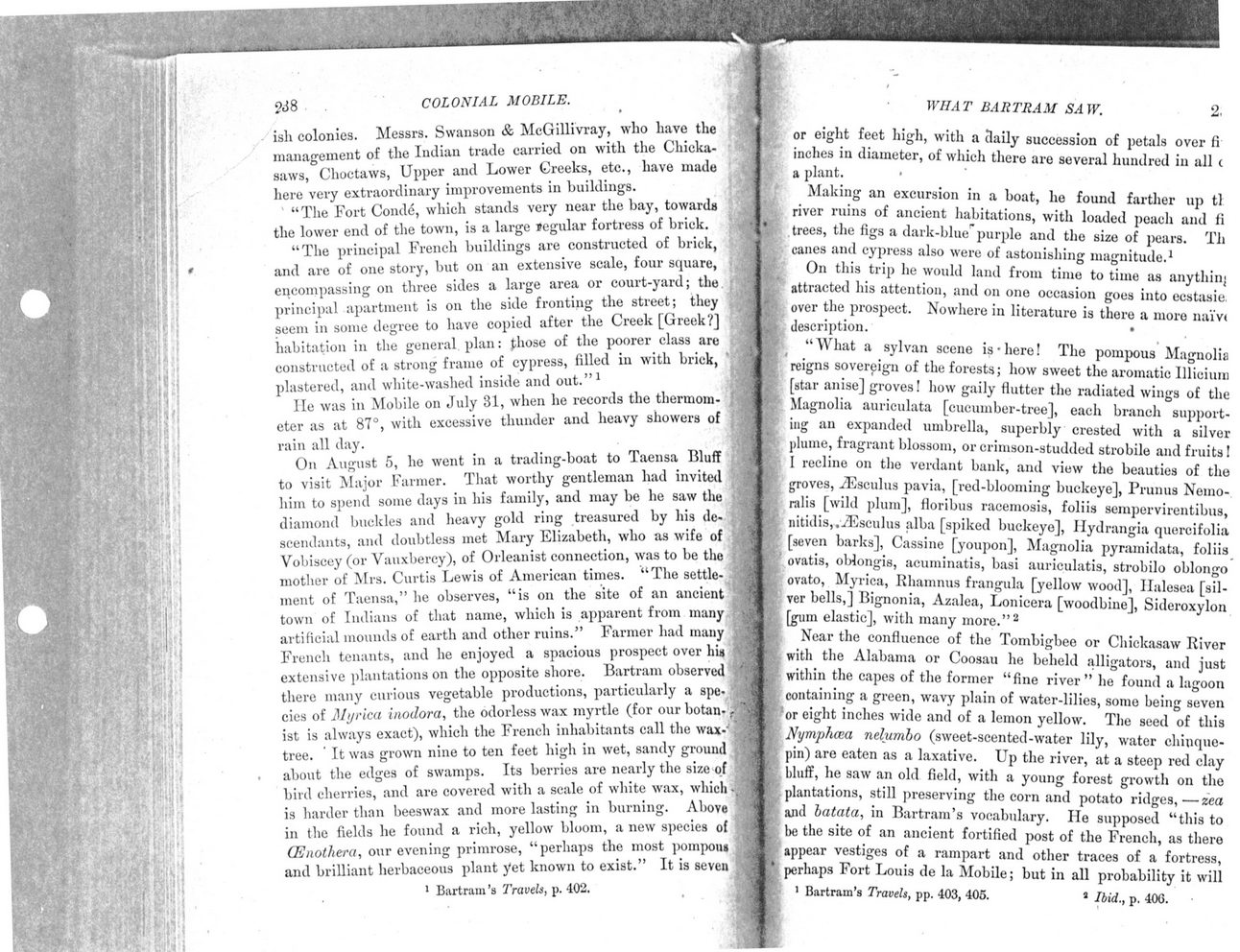This text was obtained via automated optical character recognition.
It has not been edited and may therefore contain several errors.
**" '' v'??- *?'-:' }*'*?" <t 'V
V i
,' **? . '
,:V^. .1:
.1;.*' I
;01 ft V?** S' /Ai ?
ir Sfl
'.? \T- \ ,
238
COLONIAL MOBILE.
ish colonies. Messrs. Swanson & McGillivray, who have the management of the Indian trade carried on with the Chieka-saws, Choctaws, Upper and Lower Greeks, etc., have made here very extraordinary improvements in buildings.
?The Fort Conde, which stands very near the bay, towards the lower end of the town, is a large regular fortress of brick.
?The principal French buildings are constructed of brick, and are of one story, but on an extensive scale, four square, encompassing on three sides a large area or court-yard; the principal apartment is on the side fronting the street; they seem in some degree to have copied after the Creek [Greek?] habitation in the general plan: those of the poorer class are constructed of a strong frame of cypress, filled in with brick, plastered, and white-washed inside and out.?1
lie was in Mobile on July 31, when he records the thermom- X eter as at 87?, with excessive thunder and heavy showers of ffc
rain all day. 4;
On August 5, he went in a trading-boat to Taensa Bluff to visit Major Farmer. That worthy gentleman had invited ^ him to spend some days in his family, and may be he saw the Sj. diamond buckles and heavy gold ring treasured by his de-ascendants, and doubtless met Mary Elizabeth, who as wife of if Vobiscey (or Vauxbercy), of Orleanist connection, was to be the mother of Mrs. Curtis Lewis of American times. ?The settle- ~ ment of Taensa,? he observes, ?is on the site of an ancient^ town of Indians of that name, which is apparent from inanyjj-artificial mounds of earth and other ruins.? Farmer had many f' French tenants, and he enjoyed a spacious prospect over his 4. extensive plantations on the opposite shore. Bartram observedf there many curious vegetable productions, particularly a spe- g-eies of Mynca inodora, the odorless wax myrtle (for our botan- ?r~ ist is always exact), which the French inhabitants call the wax-ty tree. It was grown nine to ten feet high in wet, sandy ground j*. about the edges of swamps. Its berries are nearly the size of bird cherries, and are covered with a scale of white wax, which is harder than beeswax and more lasting in burning. Above fe in the fields he found a rich, yellow bloom, a new species of fc (Enothera, our evening primrose, ?perhaps the most pompon* f and brilliant herbaceous plant yet known to exist.? It is seven ?/ 1 Bartram?s Travels, p. 402.
WHAT BARTRAM SA W. 2,
or eight feet high, with a daily succession of petals over fi inches in diameter, of which there are several hundred in all c a plant. ?
Making an excursion in a boat, he found farther up tl river ruins of ancient habitations, with loaded poach and li trees, the figs a dark-blue purple and the size of pears. Th canes and cypress also were of astonishing magnitude.1 On this trip he would land from time to time as anything '?tS attracted his attention, and 011 one occasion goes into ecstasie, | over the prospect. Nowhere in literature is there a more naiV( I, description. *
.f ?What a sylvan scene is-here! The pompous Magnolia * reigns sovereign of the forests; how sweet the aromatic Uliciuni ? [star anise] groves! how gaily flutter the radiated wings of the Magnolia auriculata [cucuinber-tree], each branch support-?7 ing an expanded umbrella, superbly crested with a silver plume, fragrant blossom, or crimson-studded strobile .and fruits! 1 I recline on the verdant bank, and view the beauties of the 1 Ji grovesi ^Esculus pavia, [red-blooming buckeye], Prunus Nemo-l ralis [wild pluin], floribus racemosis, foliis sempervirentibus,
? *' nitidis,..ZEsculus alba [spiked buckeye], Ilydrangia quercifolia [seven barks], Cassine [youpon], Magnolia pyramidata, foliis if ovatis, oblongis, acuminatis, basi auriculatis, strobilo oblongo ovato, Myrica, Rhamnus frangula [yellow wood], Ilalesea [sil-3* ver bells,] Bignonia, Azalea, Lonicera [woodbine], Sideroxylon ?{[gum elastic], with many more.?2
{ Near the confluence of the Tombigbee or Chickasaw River with the Alabama or Coosau he beheld alligators, and just ! within the capes of the former ?fine river? he found a lagoon I containing a green, wavy plain of water-lilies, some being seven <?or eight inches wide and of a lemon yellow. The seed of this $Nymphcea nelumbo (sweet-scented-water lily, water chinque-?'[ pin) are eaten as a laxative. Up the river, at a steep red clay ^ bluff, he saw an old field, with a young forest growth on the ^plantations, still preserving the corn and potato ridges,?zea .4 and batata, in Bartram?s vocabulary. lie supposed ?this to be the site of an ancient fortified post of the French, as there . appear vestiges of a rampart and other traces of a fortress,
" perhaps Fort Louis de la Mobile; but in all probability it will
fin. ?
I
f-
1 Bartram?s Travels, pp. 403, 405.
3 Ibid., p. 400.
u

Bartram Colonial-Mobile-What-Bartram-Saw-p.238-239